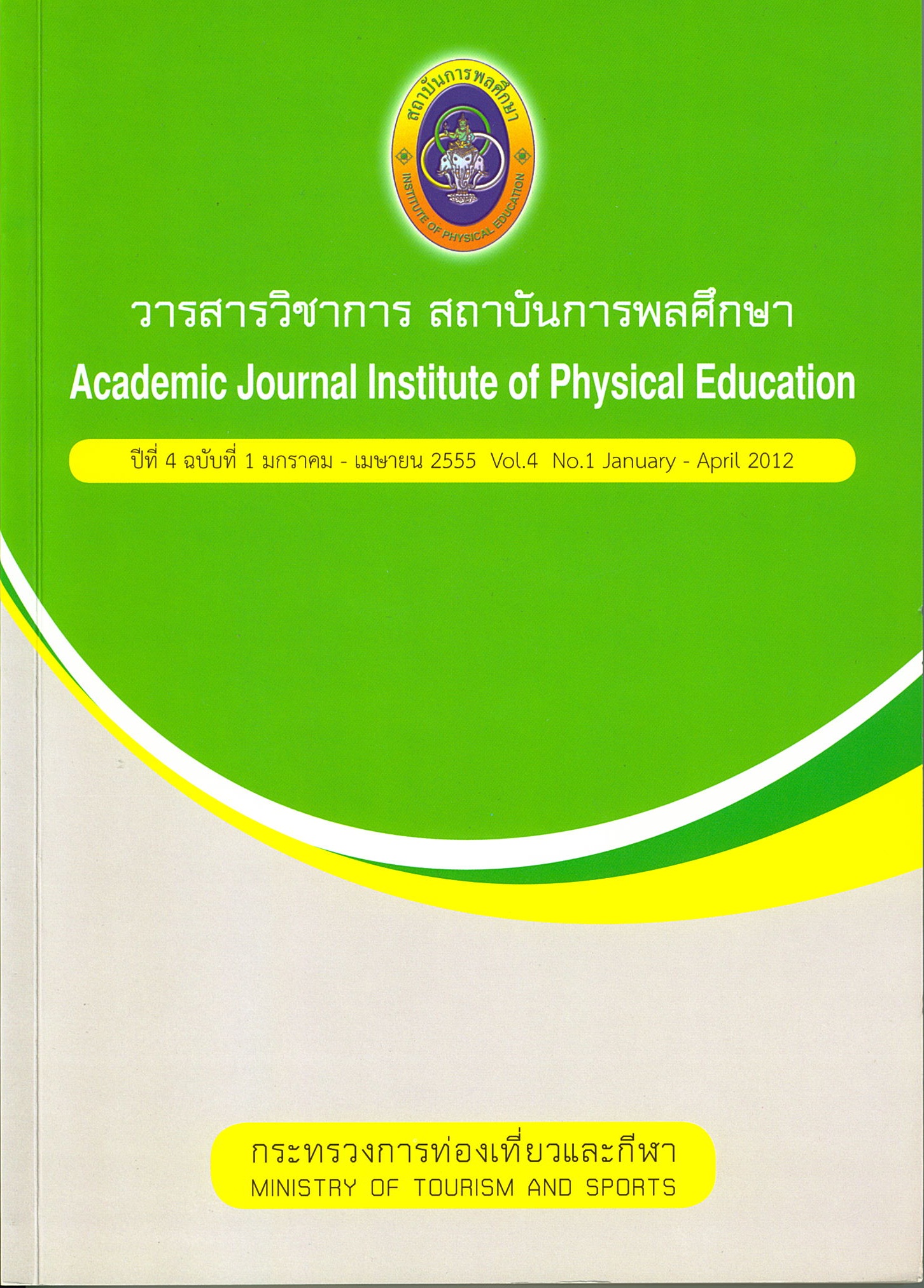DEVELOPEMENT OF A YOGA PROGRAM MODEL TO PROMOTE MEMORY AND PHYSICAL FITNESS FOR ELEMENTARY SCHOOL STUDENTS
Main Article Content
Abstract
The purpose of this study was to develop a program yoga model to promote memory as a part of intelligence and physical fitness for elementary school students. Samples were 80 elementary school students volunteered to participate and met the specific criterion. They were divided into four group of 10 males and 10 females in each group. The first group was the low intelligence-low physical fitness, the second group was the normal intelligence-low physical fitness, the third group was the low intelligentnormal physical fitness and the fourth group was the normal intelligent-normal physical fitness. The experiment carried out for 12 weeks. The experimental groups 1,2,3 trained on the yoga program while the 4th group trained nothing. Data were collected at the pretest and posttest. They were analyzed interns of mean, standard deviations , analysis of co-variance, and Bonferroni method for post hoc, at the .05 significant level.
The results were as follow :
- The development program yoga model promoted memory and physical fitness for the elementary students possessed the index of congruence (IOC), as content validity, of the warm up, the practice and the warm down as to 0.92, 0.87 and 0.91, respectively.
- There was no effect of the program yoga on facilitating the memory of all experimental groups, with the significant at the .05 level.
- In comparing the effect of program yoga on physical fitness, the experimental groups 1, 2, 3 were significant higher than the 4nd group. In addition, there were significant difference among the experimental groups at the .05 level, as follow.
3.1 For the abdominal muscular strength, the 2nd group were stronger than the 1st group, the 3rd group were stronger than the 1st group, while the 2nd and 3rd groups were not difference significant.
3.2 For the strength of hand, shoulder and chest, the 3rd group were stronger than the 1st group, the 3rd group were stronger than the 2nd group, while the 1st group and the 2nd group were not significant difference.
3.3 For the body balance, the 2nd group were better than the 1st group, the 2nd group were better than the 3rd group, while the 1st group and the 2nd group were not difference significant
3.4 For the eye-hand coordination, the 1st group were better than the 2nd group, the 3rd group were better than the 2nd group, while the 1st group and the 2nd group were not difference significant.
In conclusion, Program Yoga was effectively for improving the physical fitness promote in the elementary, especially the abdominal musclular strength, the strength of hand, shoulder and chest, the body balance and the eye-hand coordination. But memory was not clear because of maturity, experience for learning had along time in 12 weeks.
Article Details
The published article is a copyright of the Academic Journal of Thailand National Sports University. The passage appeared in each article in this academic journal is a perspective of each author which is not related to the journal. Each author is required to be responsible for all components of his/her own article. If there are any mistakes, each author must be responsible for those mistakes on his/her own.
References
กรมสุขภาพจิต กระทรวงสาธารณสุข. การพัฒนาแบบทอดสอบวัดความสามารถทางสติปัญญา WISC-II ฉบับภาษาไทย. นนทบุรี: สํานักพัฒนาสุขภาพจิต. 2547.
กมลพรรณ ชีวพันธุ์ศรี, เกราะแห่งชีวิตและครอบครัว พิมพ์ครั้งที่ 2. กรุงเทพฯ : สํานักอนามัย, 2551.
ข่าว, “ไอคิวเด็กไทย 6-12 ปี เฉลี่ย 88 จุด” คม ชัด ลึก 30 ธันวาคม 2549: 11.
รัชนี อเนกพีระศักดิ์ คู่มือทดสอบความถนัด, กรุงเทพฯ: เนชั่นบุ๊คส์, 2551.
ฮัน ไอเซนส์, ตรวจสอบวัดไอคิวตนเอง. แปลโดย ครองแผน ไชยธนะสาร. กรุงเทพ: เดลฟี, 2545.
นภูเนตร ธรรมบวร, การพัฒนากระบวนการคิดในเด็กปฐมวัย, พิมพ์ครั้งที่ 5. กรุงเทพฯ: โรงพิมพ์จุฬาลงกรณ์มหาวิทยาลัย, 2549.
Cohen, J. Statistical Power Analysis For The Behavioral Sciences. Ed 2. New York: Psychology Press, 1988.
Revinelli, R., and Hambleton, R.K. “On the use of Content Specialists in the Assessment of Criterion Referenced Test Item Validity”. Dutch Journal of Educational Research. (2)1977: 49-60.

